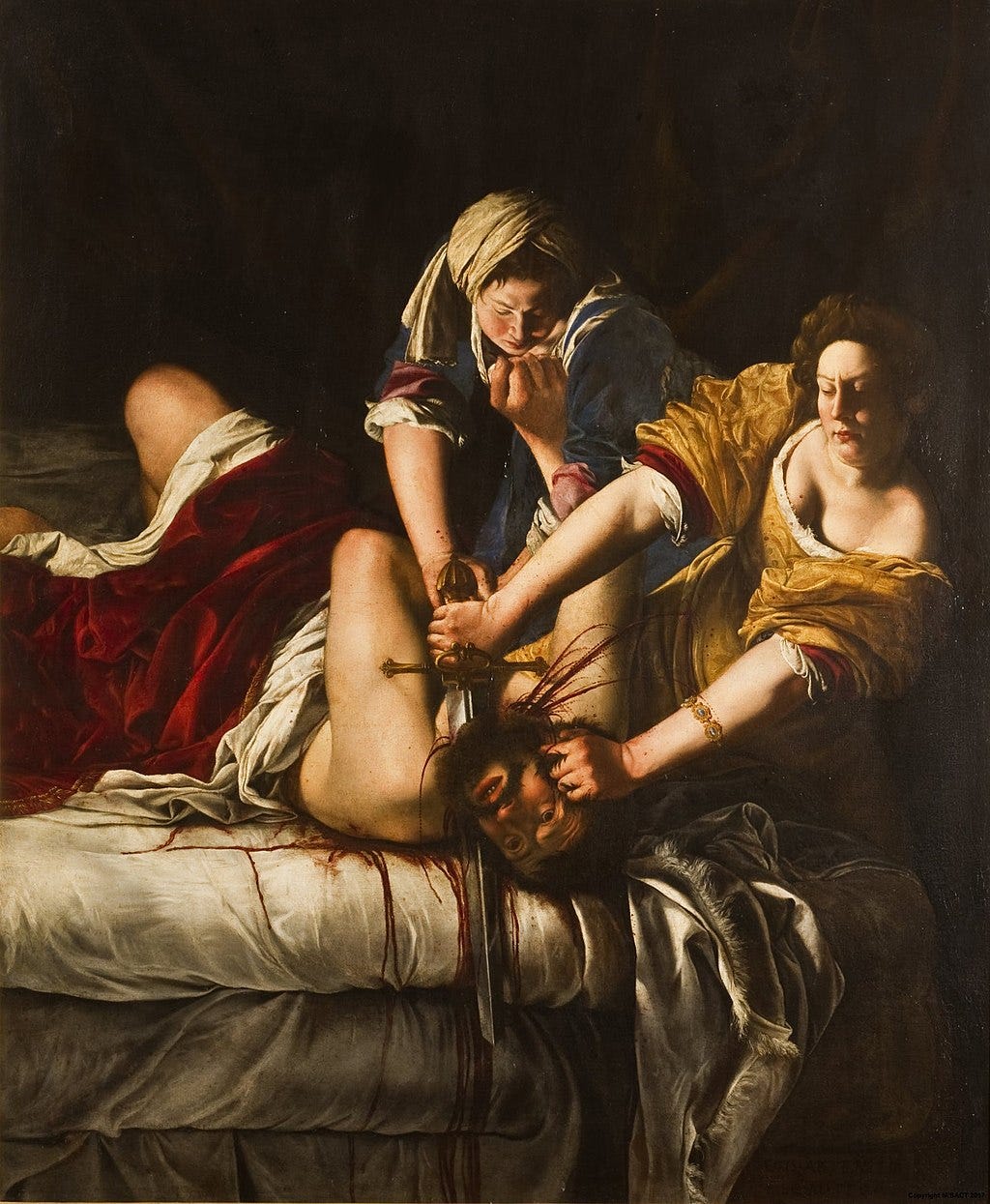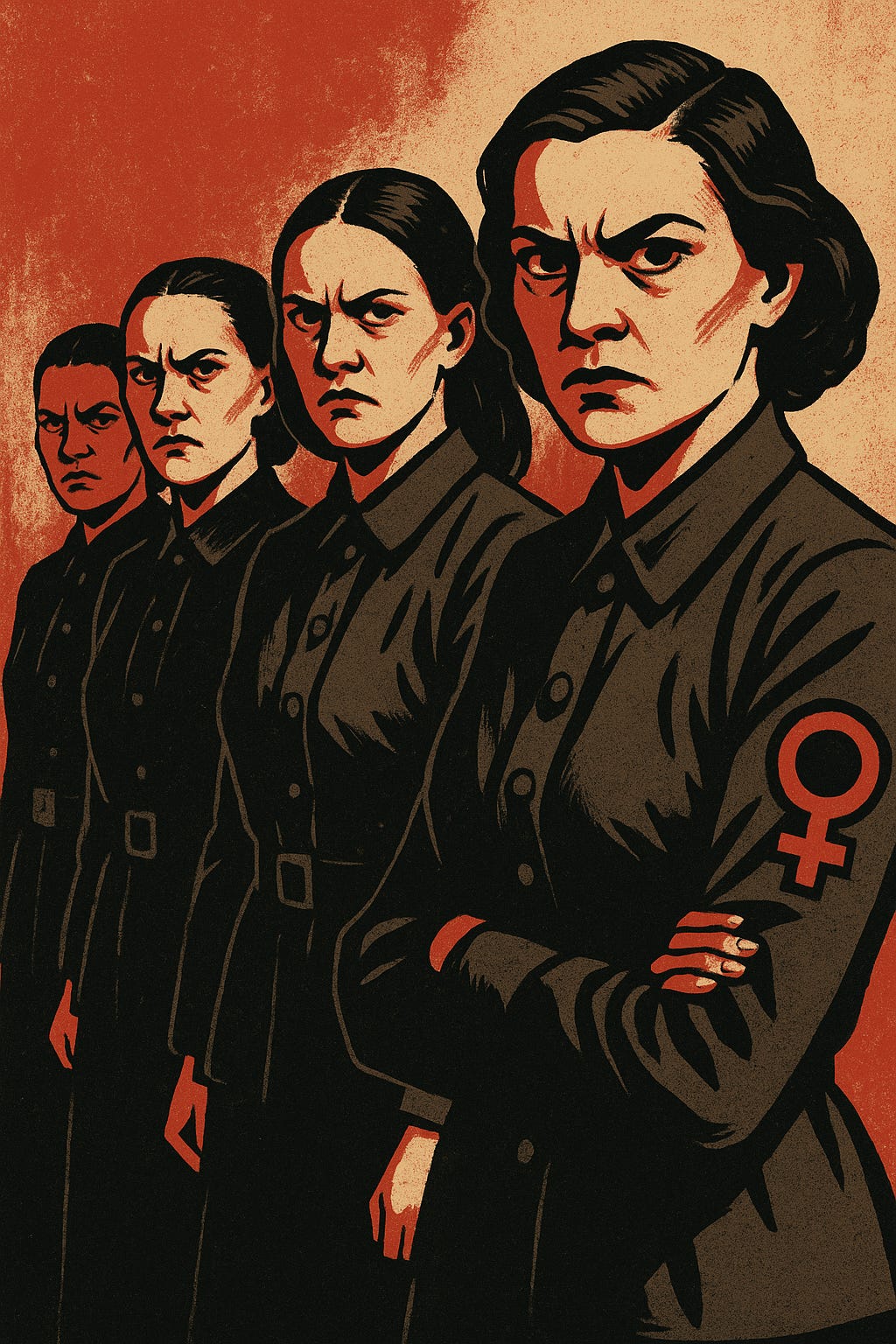The violence and sadism that define this civilisation are male violence, male sadism; its endless wars have been men's wars, whether against rival male factions, or against women, or against non-human animals, or the earth itself - Aurora Linnea
This quote from the promo for Man Against Being: Body Horror and the Death of Life portends not a critique, but a metaphysical indictment. Maleness itself cast as the source of planetary ruin. Apparently, the Mark of Cain is the Y chromosome—while the female of the species remains, one presumes, sugar and spice and everything nice.
This harkens a purification fantasy. But because feminist historiography assures us that women have been systematically brutalised by men since time immemorial, radical feminists get away with both biological essentialism and the demonisation of half of humanity. No wonder they cling so tightly to the Patriarchy Card—it launders metaphysical misandry and grants moral immunity to their ideological excesses.
Misandrist Historiography as Power/Knowledge
Feminist historiography, in its misandrist form, constructs a metanarrative in which “woman” is eternally oppressed by a singular, monolithic force called The Patriarchy. Its agents include both men and women, but—conveniently—the benefits accrue only to men. How this “male privilege” is quantified and distributed across caste, class, race, geography, or historical period is either skirted entirely or treated with the most cursory of glosses.
This mode of feminist writing functions not as historical inquiry but as mytho-history: it projects a metaphysical conception of The Patriarchy backward in time, retrofitting all of human civilisation into a morality tale of male domination and female victimhood. It flattens history, fetishises power, and reifies male guilt. What results is not historical reconstruction but political theology: a sacred narrative that stabilises feminist identity, moral certainty, and the victim/victimiser binary. It reveals much more about the psyche of the authors’ and adherents’ than it does about human history and the relations between and amongst the sexes.
This isn’t merely propaganda or red meat for radfems. It’s a proof of concept of Foucault’s power/knowledge. His argument was that knowledge is never neutral or objective; it is always entangled with power—both shaped by it and used to exercise it.1 Feminist historiography does not simply uncover oppression; it produces a regime of truth. It invents categories, narratives, and statistics that stabilise moral hierarchies, legitimise feminist authority, and determine what may be said, who may speak, and who must be silenced—especially in matters of sex and gender.
Radical feminists have constructed a discursive order in which misandry is coded as justice, and ressentiment as righteousness. Their project mirrors the structure of the very patriarchy they claim to oppose: hierarchical, moralising, punitive, and hostile to dissent.
While men have a natural monopoly on physical strength and speed, power is not a possession, nor is it the exclusive property of one sex. Power is relational, situational, and exercised through institutions, norms, and discourses—by men and women. To frame power as something men have and women lack is not only false; it is profoundly disabling and analytically crude. Victim status or being a member of a “historically marginalised group”, has become a source of cultural power to exclude and discipline under banners like “gender justice” or “smashing the patriarchy.”
The claim that men, as a sex class in and for themselves, have always oppressed women is feminist dogma, upheld by emotionally charged, often unsubstantiated assertions like the oft recycled claim that “1 in 4 women will be... by a man!” What matters is not empirical accuracy, but moralising force.2 These farfetched factoids sustain the fantasy of the violent, insatiable, sex-crazed Patriarchy. Feminist historiography, functioning as power/knowledge, refuses historical complexity in favour of a moralised just-so story.
This moral structure is also reinforced by feminism’s persistent conflation of quantity with causality. Whenever men outnumber women—CEOs, politicians, engineers—the explanation is always The Patriarchy. Historical, cultural, and biological factors are ignored. No attention is paid to what women themselves were choosing, valuing, or avoiding. Instead, numerical imbalance is treated as proof of insidious intent. Meanwhile, female dominance in fields like education, healthcare, human resources, and early childhood development, sectors that shape public values and institutional norms, is downplayed or ignored. This selective framing sustains the myth of universal male dominance and underwrites the feminist claim to moral authority.
The Dangers of Gynocentric Manichaeism
At the heart of this feminism lies a crude moral binary: male = guilty, female = innocent. Maleness is cast as the origin of violence, domination, and corruption, femaleness as the locus of care, life, and moral purity. This is a worldview in which one sex is fundamentally good, the other fundamentally evil.
This gynocentric Manichaeism eliminates nuance by reducing sexual difference to a simplistic good/evil axis. This is a very zero-sum game. It forecloses compromise let alone solidarity, rendering politics impossible. This binary precludes critique thereby insulating feminism from internal reflection. Ironically, the very logic feminism claims to oppose—that women are “naturally” predisposed to hearth and home—is simply reversed. Now, masculinity is inherently dangerous, pathologised in advance.
This structure shares a disturbing kinship with the rhetorical logic of Nazism. Consider the following:
“The personification of the devil as the symbol of all evil assumes the living shape of the Jew.” — Adolf Hitler, Mein Kampf
“The Jew is the eternal parasite… He destroys culture. He is a ferment of decomposition in every nation.” — Alfred Rosenberg, The Myth of the Twentieth Century
“The Jew is the ferment of the decomposition of the people.” — Joseph Goebbels, Nuremberg speech, 1937
Now compare:
“The violence and sadism that define this civilisation are male violence, male sadism.” —Aurora Linnea, Man Against Being
Note the fascist structural logic:
The “degenerate” race pollutes the nation
The “parasitic” Jew corrupts the social order
The “masculine” principle ravages women, animals, and the earth
In both Nazism and misandrist feminism, a singular group is positioned as the root cause of all disorder. They are not treated as contingent historical actors, but as inherently corrupt—or corrupting—by nature. Civilisational decay is laid at their feet, and their very existence is framed as an existential threat. Whether the enemy is the Jew or The Patriarchy, the structure is the same: the problem is totalised, the enemy essentialised, and the fantasy of removal or unconditional surrender becomes a substitute for the slog of figuring out how best to live together.
Thankfully, no misandrist feminist regime will come to power. But the fantasy persists—a perverse structure of feminist enjoyment. Men become objects of endless denunciation. Feminist subjects enjoy their righteous indignation while enjoying the built environment and modern conveniences overwhelmingly built and maintained by the men they denounce. Rest assured, the author of Man Against Being does not live outside male-built civilisation she condemns. Nor, one suspects, does she actually really desire to.
Misandry offers symbolic catharsis—a moral performance that titillates the radfem psyche. But ultimately, the fantasy is self-defeating. It infantilises women, substitutes ressentiment for critique, and displaces the real contradictions of capitalism—imperialism, bureaucracy, alienation, transhumanism and industrial civilisation’s metabolic rift with nature—onto a mythical Patriarchy. As if women are all merely passive bystanders or victims. As if violence, in all its forms, were a uniquely male phenomenon.
The misandric feminist imagination does not seek truth and reconciliation. It enjoys moral certainty and desires a purified world. But fantasies of purification never end well. . .
“We are subjected to the production of truth through power and we cannot exercise power except through the production of truth.” Foucault, “Truth and Power,” in Power/Knowledge: Selected Interviews and Other Writings, 1972–1977, p. 93.
The “1 in 4” statistic originated from advocacy-driven campus surveys in the 1980s and 1990s, particularly the work of Mary Koss, whose study defined rape and sexual assault expansively and included instances where participants themselves did not label their experiences as such. Critics have noted the slippage between legal definitions, personal interpretations, and activist frameworks. Later studies using different methodologies (e.g. National Crime Victimization Survey) report significantly lower rates, but the “1 in 4” claim persists in media, university materials, and activist literature.





